Aude (Languedoc-Roussillon)
At the foot of the Pyrenees lies the department of Aude in the Languedoc-Roussillon region. A region known for its beautiful nature, delicious wine and the history of the Cathars. This region in the south of France is generally very sunny. Our route introduces you to this beautiful region. We start in Narbonne on the Mediterranean coast and head inland on winding roads past beautiful vineyards. Then we drive towards the Pyrenees, where we visit the most important sites and castles of the Cathars. Built high up on dizzying rocks are the castles of Peyrepertuse and Quéribus. This tour is not only an interesting dive into history, but also quite a sporty affair. If you want beautiful views, you have to be prepared for a tough climb. Besides castles, we also visit numerous small villages and enjoy long walks through the beautiful, mountainous nature.
Total distance of the route: 342 km
Narbonne
We start our road trip in one of the oldest cities in France. Narbonne is the first settlement founded by the Romans outside Italy, then called Colonia Narbo Martius. Today, Narbonne is a pleasant town close to the Mediterranean Sea. The historical centre is perfect to explore on foot. The Cathédrale Saint-Just et Saint-Pasteur is dedicated to the martyrs of the same name. In the 13th century, the construction of the grand cathedral began, but was never fully completed. The outbreak of the plague was certainly one of the reasons. On the same square as the cathedral, you will find the Archbishop's Palace. The Canal de la Robine is one of the most beautiful places in Narbonne. As a branch of the Canal du Midi, it connects Narbonne with the Mediterranean Sea. Walk or cycle along the sunny quays with old buildings. Les Halles de Narbonne have been a household name for over 100 years and are one of the most beautiful market halls in France. You can go there every day for fresh fruit and vegetables, fresh fish and regional products.
Be sure to spend some time at the coast. Near Narbonne is the fishing town of Gruissan. Gruissan Plage, the old centre of the town, can be recognised by its extensive beaches and many restaurants. The beaches belong to the Parc Régional de la Narbonnaise en Méditerranée. In this nature reserve, you can expect a varied landscape: lagoons, sandy beaches, vineyards and the rocky massif of La Clape are waiting to be explored.
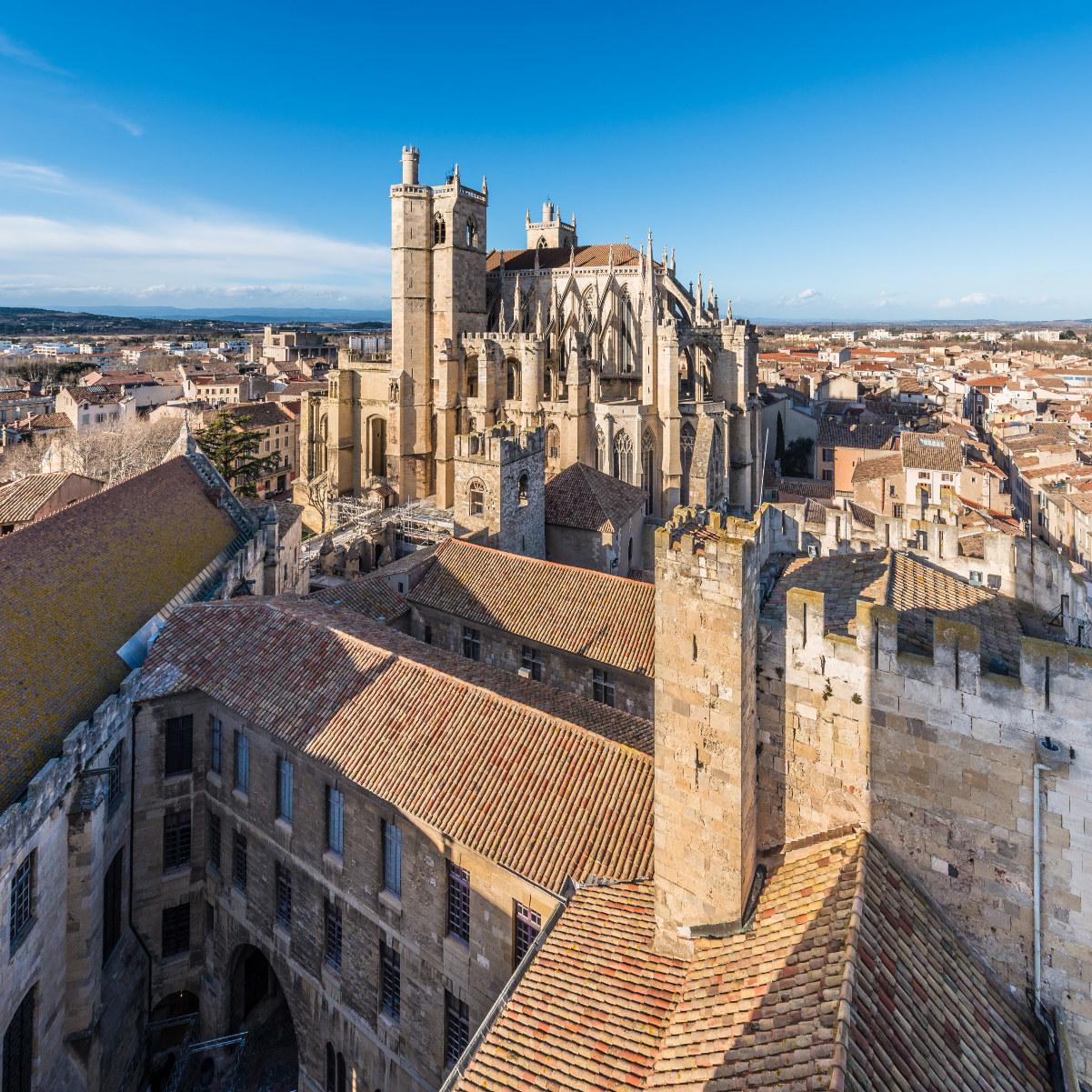
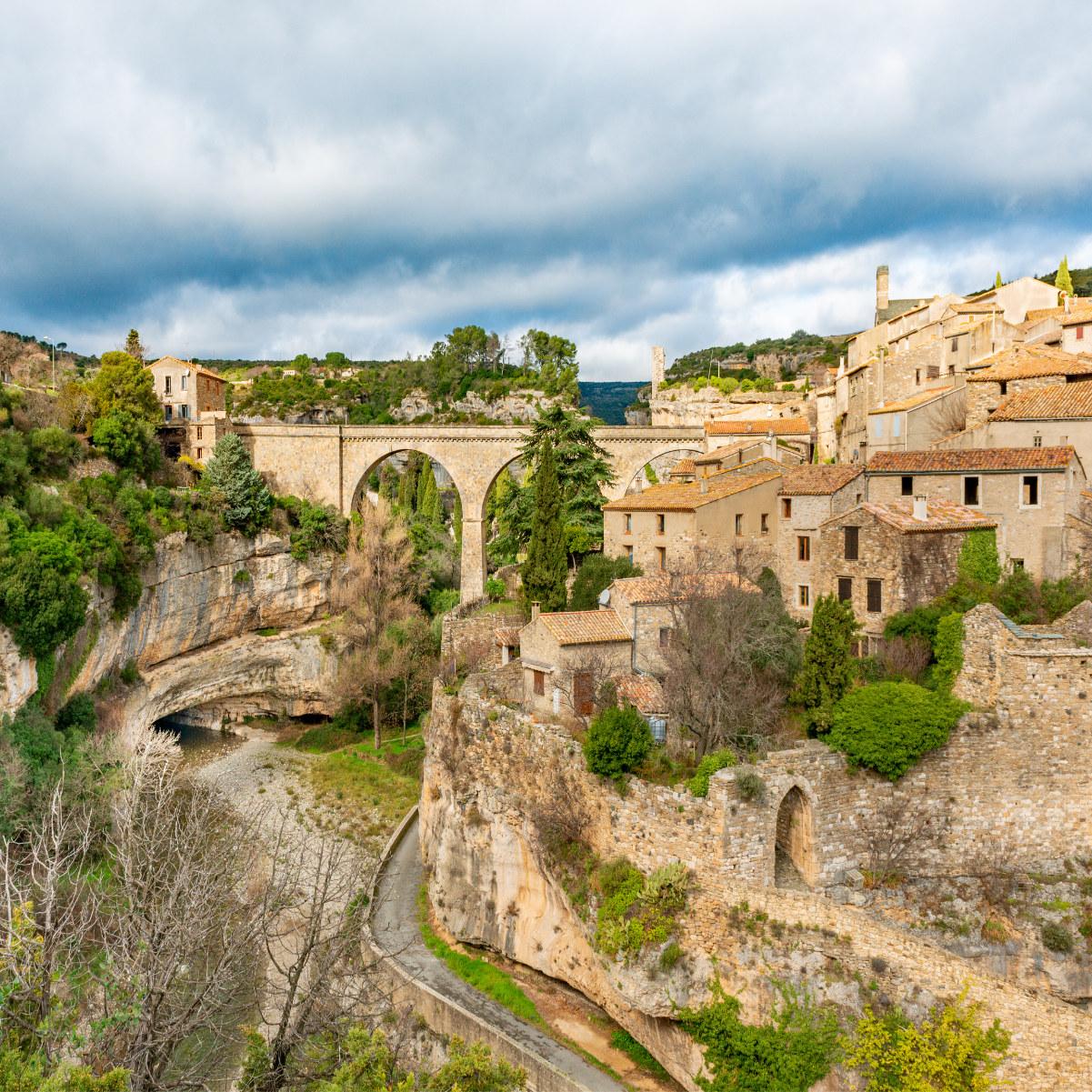
Narbonne - Lastours
The Aude region is known for the Cathars, a Christian movement from the 12th and 13th centuries. The community was mainly located in Occitania and strived for a pure faith. This caused conflict with the Roman Church and eventually led to a crusade and the persecution of the Cathars. On this road trip, you cannot avoid their past. The first major massacre took place in the village of Minerve. More than 180 Cathars were executed on the square in front of the town hall. Despite this heavy history, Minerve is a beautiful village. Located where the rivers Cesse and Briant meet and surrounded by rocky surroundings, Minerve is rightly one of the most beautiful villages in France. Please note that Minerve is not accessible to cars, you can park in the large car park in front of the town. In the vicinity you will also find the Gorges du Brian.
Via the villages of Rieux-Minervois and Villeneuve-Minervois we follow the D111 to Lastours. Lastours has four medieval towers/castles that used to form Château Lastours. The towers look proudly out over the valley of Orbiel. From the watchtower Montfermier, you have the most beautiful view over the remains of Château Lastours. You can reach the ruins from Lastours via the large car park on the outskirts of the village. From there, the steep walk to the first tower starts. Tip: wear good walking shoes!
Lastours - Montolieu
From Lastours, we drive via Mas-Cabardès to Montolieu. On the way, you can stop at Le Moulin à Papier de Brousses. Montolieu is the heart of the Cabardès wine region and is situated high on a rocky outcrop. The fortified village stretches over the rocky cliff between the steep valleys of the Dure and the Alzeau. Montolieu lived from the wool and linen industry for a long time, but is now known as 'Village du livre'. And the village owes this name to its 20 or so bookshops and bookbinders. Besides French books, you can also find English, German, Spanish and even Dutch literature. Be sure to wander through the gallery of second-hand books. Walk from bookshop to bookshop and discover the old streets of the village. In the Conservatoire des métiers du livre, or Michel Braibant Museum, you can learn everything about the history of books. You can also attend a bookbinding or calligraphy workshop. Besides books, the 14th century l'église Saint André will not escape your notice. The church has an impressive bell tower of 38 metres high. Not far from Montolieu, you will find l'Abbaye de Villelongue, a former Cistercian abbey, beautifully situated on the banks of the river, hidden between hundred-year-old trees.
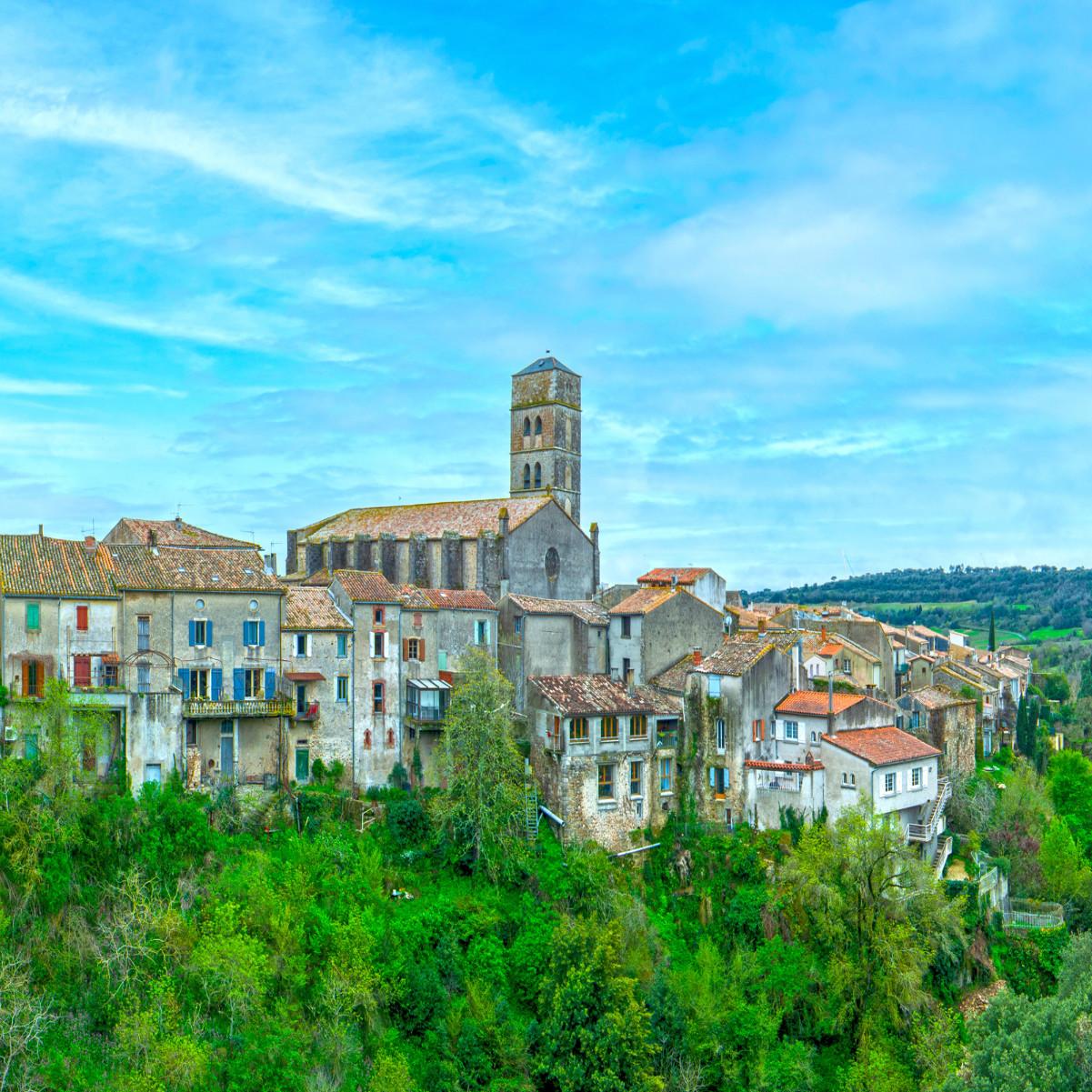

Carcassonne
Carcassonne, one of the most visited places in France, is an ancient fortified city through which both the Aude and Canal du Midi flow. Carcassonne has been on the UNESCO World Heritage List since 1997. There are two striking parts in the city. The medieval Cité is connected with the lower city by two bridges over the Aude: the Pont Vieux and the Pont Marengo. Carcassonne was founded as a large fortified trading settlement in the 8th century B.C. and was given the name Carsac. A few centuries later and a few kilometres further, the Romans built the city of Carcaso. This settlement grew into an important city. After the crusade against the Cathars (1229), the city officially became part of France. Especially the medieval Cité appeals to everyone's imagination. The city walls loom up from afar. Especially in the high season, Carcassonne is a busy attraction. The Cité contains the castle of Château Comtal, 4 city gates, the basilica of St. Nazaire, 3 km long double city walls and 52 towers. So take time to visit all this and let yourself be overwhelmed by the medieval splendour. But also the Bastide of Ville-Basse, the lower part of the city, is worth a visit. It is the administrative and commercial heart of the city. You can eat and drink here and walk along the fountain of Neptune, the cathedral of Saint-Michel and the church of Saint-Vincent.
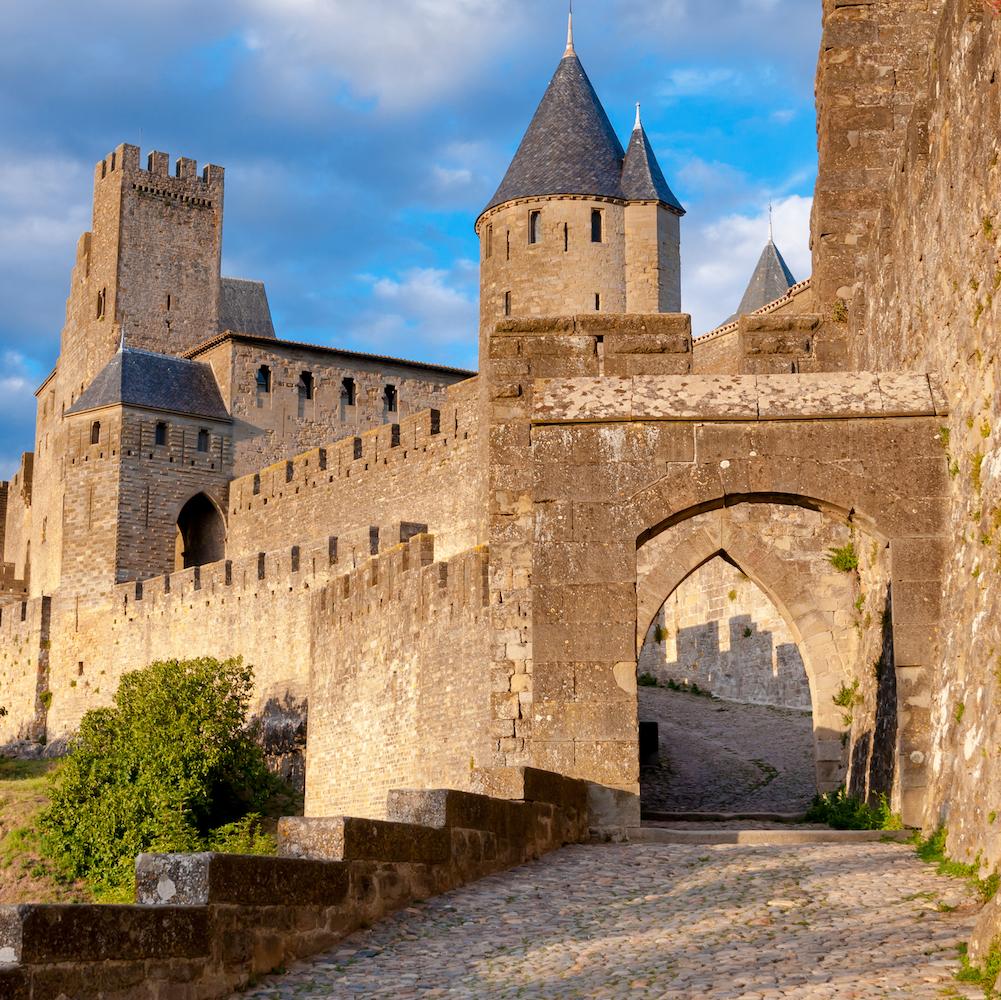

Carcassonne - Rennes-le-Château
After Carcassonne, we drive south to Limoux, the city known for the traditionally prepared wine 'blanquette'. There is also an annual Carnival festival. Various sources indicate that the area around Limoux has been inhabited since prehistoric times. Because of its good location, Limoux quickly grew into a pleasant trading town. You can stop and admire the Pont-Neuf de Limoux, or see the remains of various fortifications from the 14th century. The basilica of Notre-Dame de Marceille is also worth a visit. In the vicinity of Limoux, there are numerous lovely villages where you can make a short stop. The ring village of Loupia is one of them. From Limoux, we drive via Alet-les-Bains - the village with the beautiful Romanesque abbey - to the mysterious Rennes-le-Château. This place has only about 100 inhabitants, but has become world-famous because of the legend of the Holy Grail. You wouldn't know it now, but in 1062, Rennes-le-Château was very powerful. It was a city with as many as 30,000 inhabitants. However, it all fell into disrepair to such an extent that almost nothing was left of the city. In the 19th century, the priest Bérenger Saunière carried out enormous repairs to the church, but no one knows where he got the money to do it. The story goes that the priest had found the Holy Grail, a treasure of the Cathars, in the remains of the church. But, all this remains a true mystery. For this reason, the village has appeared in various historical thrillers such as The Da Vinci Code (Dan Brown) and The Lost Labyrinth (Kate Mosse).
Rennes-le-Château -Puilaurens
From Rennes-le-Château we drive deeper into the Pyrenees and start our tour along the castles and fortresses of the Cathars. First stop: the castle of Puivert. Puivert was attacked during the crusade against the Cathars, but is not one of the most impressive castles. However, of all the castle buildings from the first half of the 14th century in the region, Puivert is one of the best preserved. The castle radiates a kind of serenity. The large keep is completely intact and inside you will find four beautiful rooms, including the 'salle des Musiciens'. This room is decorated with eight sculptures of musicians, hence the name. After Puivert, we drive further to Quillan, a nice place with a very lively town centre with some restaurants on the central square. In Quillan, you can make beautiful walks through the mountains. We follow the river Aude further to Axat, a popular spot for sports lovers: rafting, kayaking, abseiling, canyoning, mountain biking or hiking, it is the ideal place for it. The next castle on the route is that of Puilaurens, one of the most important places in the history of Catharism. Puilaurens is situated high on a rock, built in the 11th century. After the fall of Montségur, many Cathars sought refuge here. When visiting, you can expect a steep climb, so don't forget to wear good shoes. The outer walls are certainly impressive and have withstood the ravages of time remarkably well. The view is also beautiful.
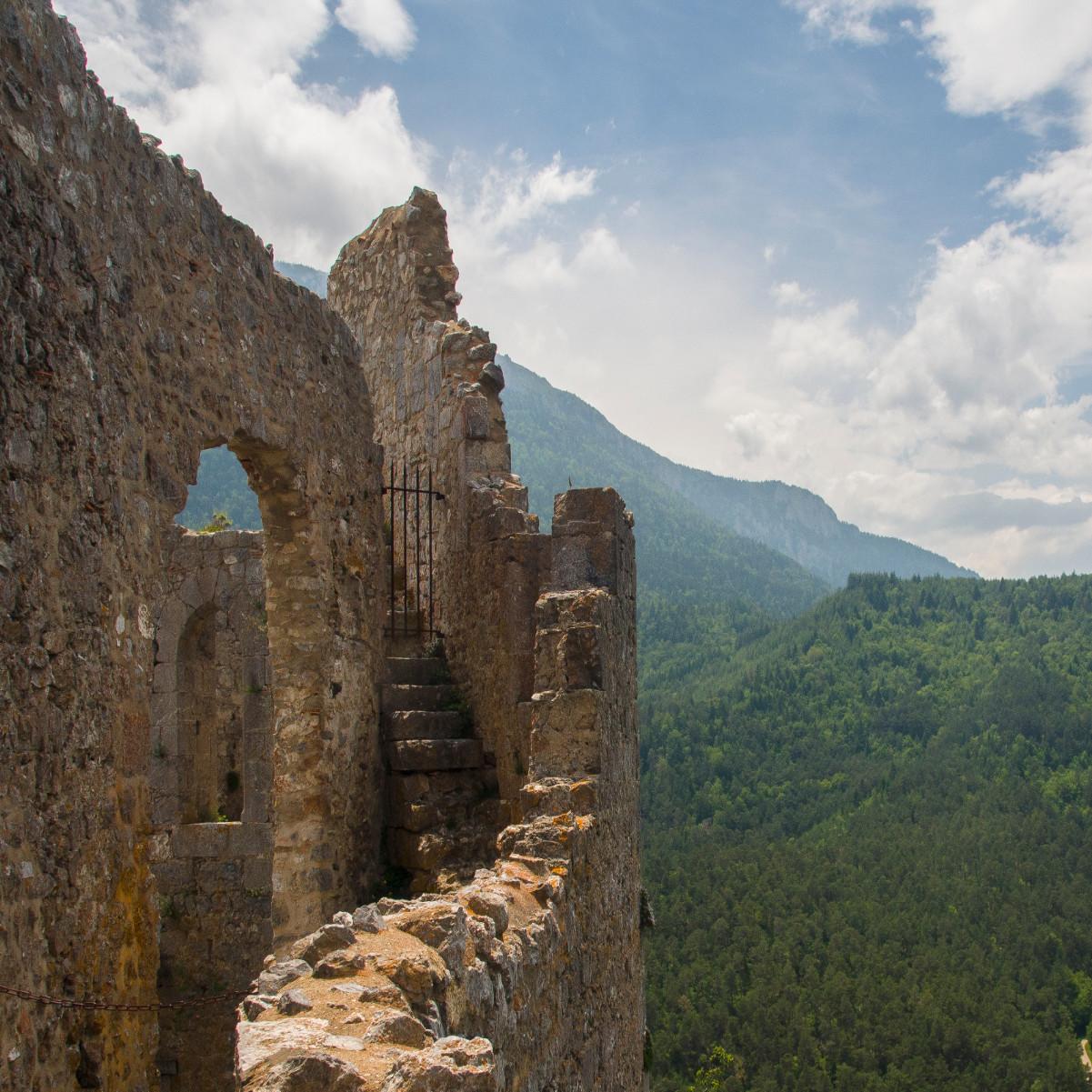
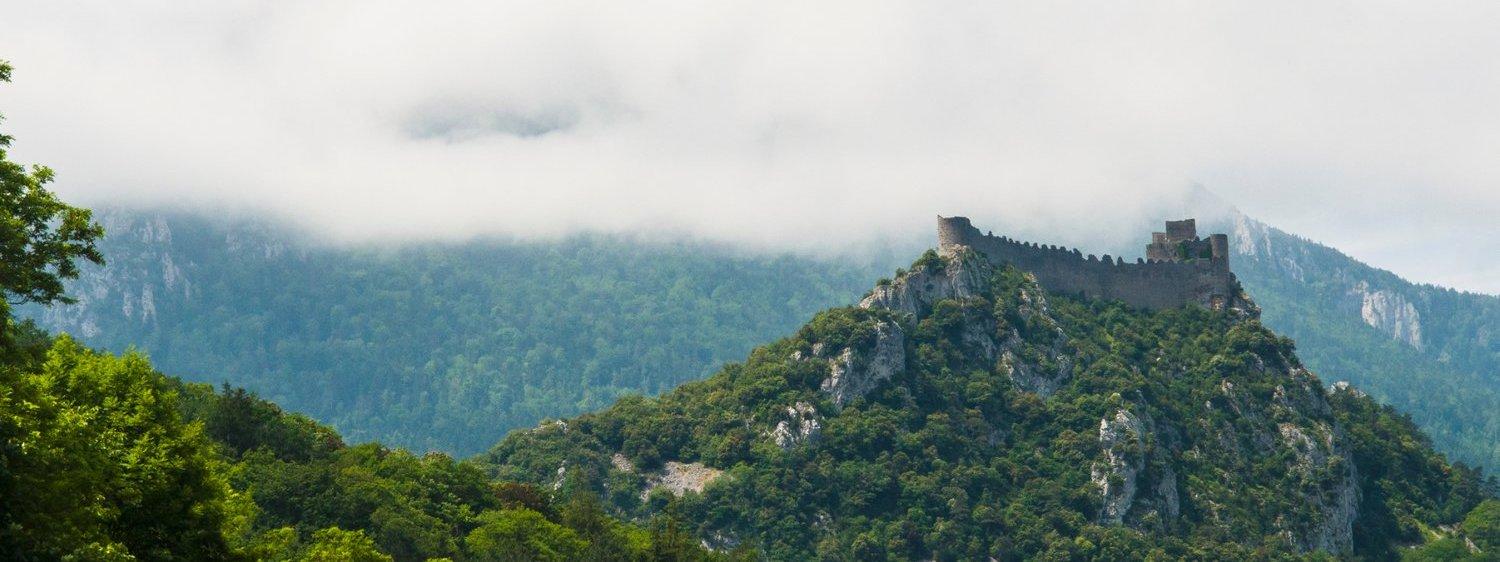
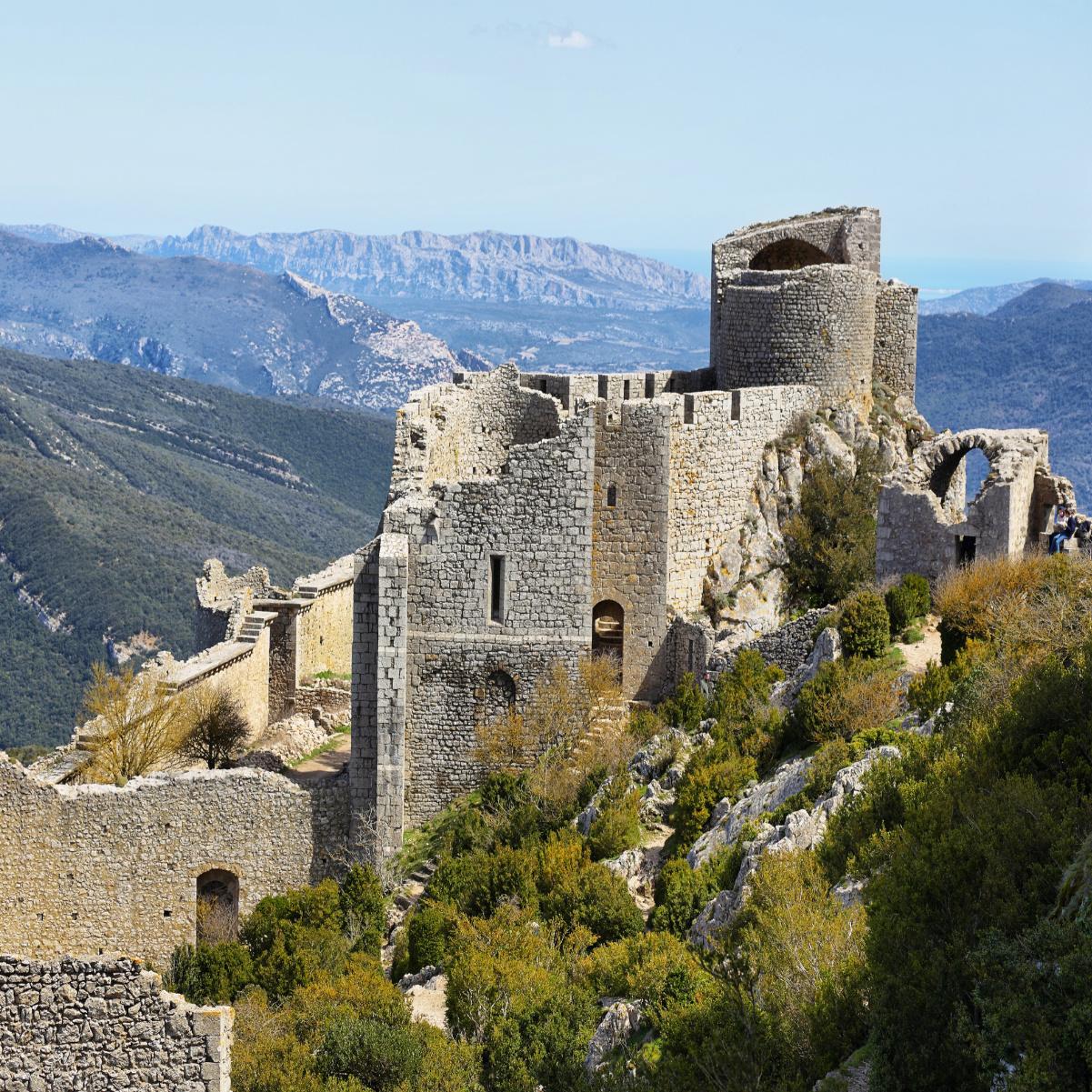
Puilaurens - Cucugnan
Follow the D117 to Maury and then turn off to the Castle of Quéribus. After the fall of Montségur, Quéribus was also a place of refuge for the Cathars, hoping to find protection there against the Crusaders. Legend has it that the Cathars smuggled the Holy Grail from Montségur to Quéribus. There is not much left of the castle. However, from the ruins you still have an impressive view of the Pyrenees. The last Cathar castle on our route is also the biggest: Peyrepertuse is situated high on a rock, 300 metres long. The total area of Peyrepertuse is just over one hectare. The lower ramparts contain the remains of the primitive castle dating from the 12th century. The higher part dates from a century later. After the castle fell into French hands, it was further expanded. Despite the many Franco-Spanish conflicts, Peyrepertuse was never attacked or conquered. The castle lost its strategic value and therefore fell into disrepair. At the foot of the hill there is a large car park. The climb to the castle takes about twenty minutes, but it is absolutely worth it because the view from the rock is breathtakingly beautiful. You can therefore spend a few hours there.
Cucugnan - Lagrasse
Between Quéribus and Peyrepertuse lies Cucugnan, a picturesque village with about 100 inhabitants. Cucugnan is a real wine village, surrounded by the vineyards of the Corbières. In the church, you will find the striking statue of the pregnant virgin Mary. Perhaps the name 'Cucugnan' rings a bell. The French writer Alphonse Daudet wrote about "Le curé de Cucugnan" in his collection of stories "Lettres de mon moulin", which catapults you back to French class at school. Father Martin lures the inhabitants of Cucugnan back to his church with a "sermon of thunder". As a result, Cucugnan became the most devout village in France. It is a lively village with many good eating places and some caves where you can taste various wines. A nice change after the castles. On the way to Lagrasse, you can stop at the castle of Aguilar, Villerouge-Termenès and the castle of Terme. Take a stroll around Lagrasse. Walk over the old bridge over the Orbieu, visit the market hall or the Benedictine abbey of Sainte-Marie l'Orbieu. Lagrasse has been known for more than ten years as one of the most beautiful villages in the Aude department. The abbey of Sainte-Marie l'Orbieu was probably founded around the year 778 and quickly became one of the most important abbeys in the south of France.
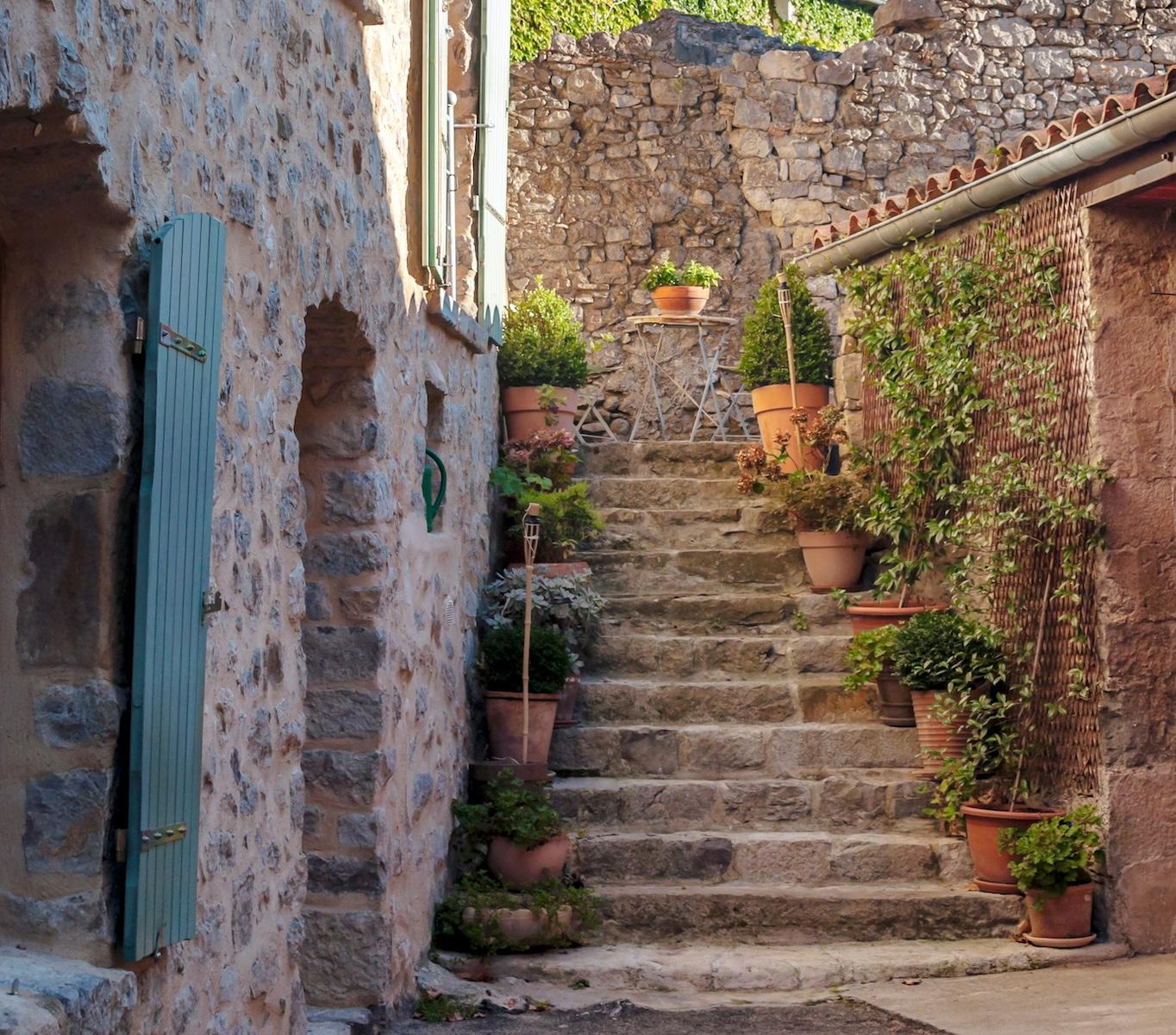
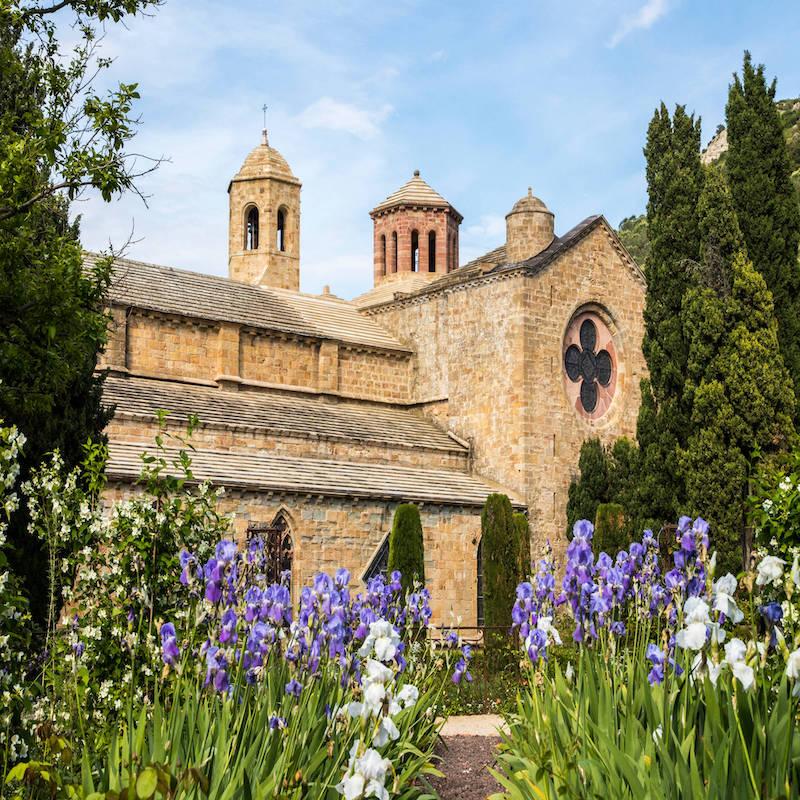
Lagrasse - Abbaye de Fontfroide
Our last stop is the Abbaye de Fontfroide, a former Cistercian abbey located close to Narbonne in the Corbières valley. This idyllic abbey is completely surrounded by cypress trees, which gives you the feeling of being in Tuscany. As a visitor, you are guided through all the special places of the abbey, including the dormitory of the lay brothers and the monastery garden. Prefer not to be accompanied? You can also explore the abbey on your own. The monastery garden is definitely a must! The abbey dates from 1093 and went through an unprecedented period of prosperity in the 13th century.
Would you like to visit some nature before heading home? Then you can drive further to Parc Naturel Régional de Narbonnaise en Méditerranée. This 80,000 hectare regional park consists of a very varied landscape. It is a large piece of unspoilt nature. From lagoons and sandy beaches on the Mediterranean to vineyards and scrubland of Corbières or the rocky massif of La Clape. A nice ending to a beautiful road trip through Departement Aude.
Can't get enough of the Pyrenees? Then be sure to check out our road trip through the French Pyrenees.

